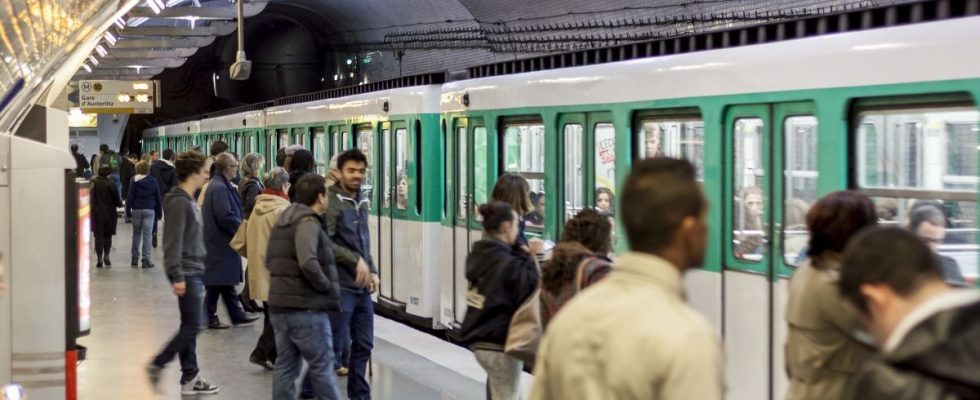Published on
Updated
Reading 3 mins.
For several months, a team of journalists carried out an investigation into the air quality in the Paris metros and RERs. Yet another study whose results are quite alarming. Doctissimo takes stock.
Relayed in the newspaper “The Parisian” of this Tuesday, May 23, a study carried out by the team of journalists from the program “Vert de rage” on France Television, demonstrates the poor quality of the air in the Parisian underground network. Fine particles emitted by traffic come from accumulate to those coming from the outside air, which causes an effect of “over-pollution.” And according to the results of their research, certain metro and RER lines are more polluted than others.
To carry out their study, twelve journalists analyzed the air quality of the Parisian underground network for eight months. For this, they took into account the concentration of fine particles (PM 2.5) – less than 2.5 microns in size – linked to pulmonary and cardiovascular problems… These analyzes were carried out in 332 metro and RER stations Ile-de-France (zones 1 and 2), between 6 p.m. and 8 p.m., when the rate of travelers is the highest.
According to the results of this study, the “overpollution” emitted by metro and RER traffic is twice as high as the recommendations made by the World Health Organization (WHO). Another observation, the presence of heavy metals in the Parisian underground network has been confirmed with iron, manganese and nickel contents “higher than normal”.
“Their origin is not in doubt”, estimated for the Parisian, Joël Poupon, biologist at the toxicological laboratory of the Lariboisière hospital, after having analyzed nose filters, tested on around forty travelers and around ten drivers. According to him, these particles are “from braking and rails”. “It is not alarming, but health risks cannot be excluded”added the expert.
“When you blow your nose, it’s black”
For Bruno Crestani, head of the pneumology department at Bichat hospital in Paris and interviewed by our colleagues from the newspaper “Le Parisien”, this pollution “may have consequences for the health of those who work there”. On the other hand“for a user who spends an average of 36 minutes a day in the metro (and longer in a car than on the platforms, where the measurements are taken), this is not so much of a concern”adds the expert, specifying that what matters most is the duration of exposure to fine particles.
Following the revelations of this umpteenth study on the air quality of the Paris metro and RER, many RATP employees directly impacted say they are worried. “We just want to know what we are exposed to to better protect ourselves. In our time, it is incomprehensible to always be there”, explained François-Xavier Arouls, co-secretary of Solidaires-RATP and driver on line 3, for Le Parisien. For Arnaud Mocquelet, of the CGT-RATP, “we come up against a kind of silence from the management”. “However, when you blow your nose, it’s black. That alone is not normal”he adds.
Future measures to improve air quality?
Always according to The Parisianthe RATP group’s sustainable development manager, Sophie Mazoué “there is no silver bullet to improve air quality”. However, it specifies that experiments have been set up to improve air quality. One of them, tested since 2020, consists in capturing the particles emitted at their source thanks to a brake lining designed by the company Wabtec. “Three RER A trains are already equipped with it and seven others should be before the end of the year,” explains Sophie Mazoué.
The RATP group’s sustainable development manager also adds that ventilation systems are being created and others are being reinforced to improve air quality. However, she adds that improving air quality “will go through a sum of experimentation” and “all of this takes time.”
What is the most polluted line?
To establish their ranking, the authors of this study took into account the “level of additional particles at the station relative to the surface in µ/mg3.” In the top 3 of the most polluted lines, we find metro 5 in first place with +18 µ/mg3then just behind RER A with +17 µ/mg3 and finally, in third position: metro 9 with +16 µ/mg3. The least polluted metro line of all, corresponds to that of metro 12, with only +2.5 µ/mg3.
Here is the final ranking published in Le Parisien:
- Line 5 (+18µ/mg3);
- The RER A (+17µ/mg3);
- Line 9 (+16µ/mg3);
- Line 2 (+15.5µ/mg3);
- Line 7 (with +15 µ/mg3);
- Line 7bis (+15µ/mg3);
- Line 13 (+13.5µ/mg3);
- Line 8 (+13.5µ/mg3);
- The RER B (11.5µ/mg3);
- The RER D (+11µ/mg3);
- Line 11 (+11µ/mg3);
- Line 1 (+9 µ/mg3);
- Line 12 (+8µ/mg3);
- Line 10 (+7µ/mg3);
- Line 6 (+5 µ/mg3);
- Line 4 (+5 µ/mg3);
- Line 3 (+4.5µ/mg3);
- The RER E (+4.5µ/mg3);
- RER C (+3 µ/mg3);
- Line 14 (+3 µ/mg3);
- Line 3bis (+2.5µ/mg3).
